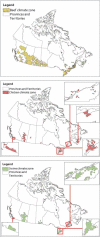Seasonality and zoonotic foodborne pathogens in Canada: relationships between climate and Campylobacter, E. coli and Salmonella in meat products
- PMID: 31364535
- PMCID: PMC6518574
- DOI: 10.1017/S0950268819000797
Seasonality and zoonotic foodborne pathogens in Canada: relationships between climate and Campylobacter, E. coli and Salmonella in meat products
Abstract
Infections due to Campylobacter, Escherichia coli and Salmonella pose a significant health burden in Canada, resulting in major costs to the health care system and economic impacts due to lost productivity resulting from illness. Recent literature suggests that climate may play a role in the prevalence of these pathogens along the food chain. This study used integrated surveillance data to examine associations between weather variables, serving as a proxy for climate, in agricultural areas and Campylobacter, generic E. coli and Salmonella contamination on samples of beef, poultry and swine meat products in Canada. Various temperature metrics (average, maximum and variability) were correlated with Campylobacter prevalence along the food chain. The prevalence of E. coli and Salmonella was correlated with both precipitation and temperatures metrics; however, analysis for E. coli was limited to beef and swine meats at retail settings, because prevalence in other combinations approached 100%, which obviated further analysis. Campylobacter contamination in poultry and swine at abattoir and retail settings demonstrated a seasonal trend, with increased prevalence generally from June or July through November, compared to the baseline month of December. Based on these analyses, Campylobacter is the most likely foodborne bacteria studied whose occurrence in meat products is affected by climatic changes in Canada. An exploratory analysis of data at the provincial scale, using Ontario as an example, revealed similar directional relationships between climate and bacterial prevalence.
Keywords: Campylobacter; Escherichia coli (E. coli); climate; food-borne zoonoses; impact of; salmonella.
Conflict of interest statement
None.
Figures




References
-
- Copeland L and Wilcott L (2006) Evidence Review: Food Safety. British Columbia, Canada: BC Ministry of Health, CORE public health functions for BC. Available at: https://www.health.gov.bc.ca/library/publications/year/2006/food-safety-... (Accessed 1 August 2015).
Publication types
MeSH terms
LinkOut - more resources
Full Text Sources
Medical

